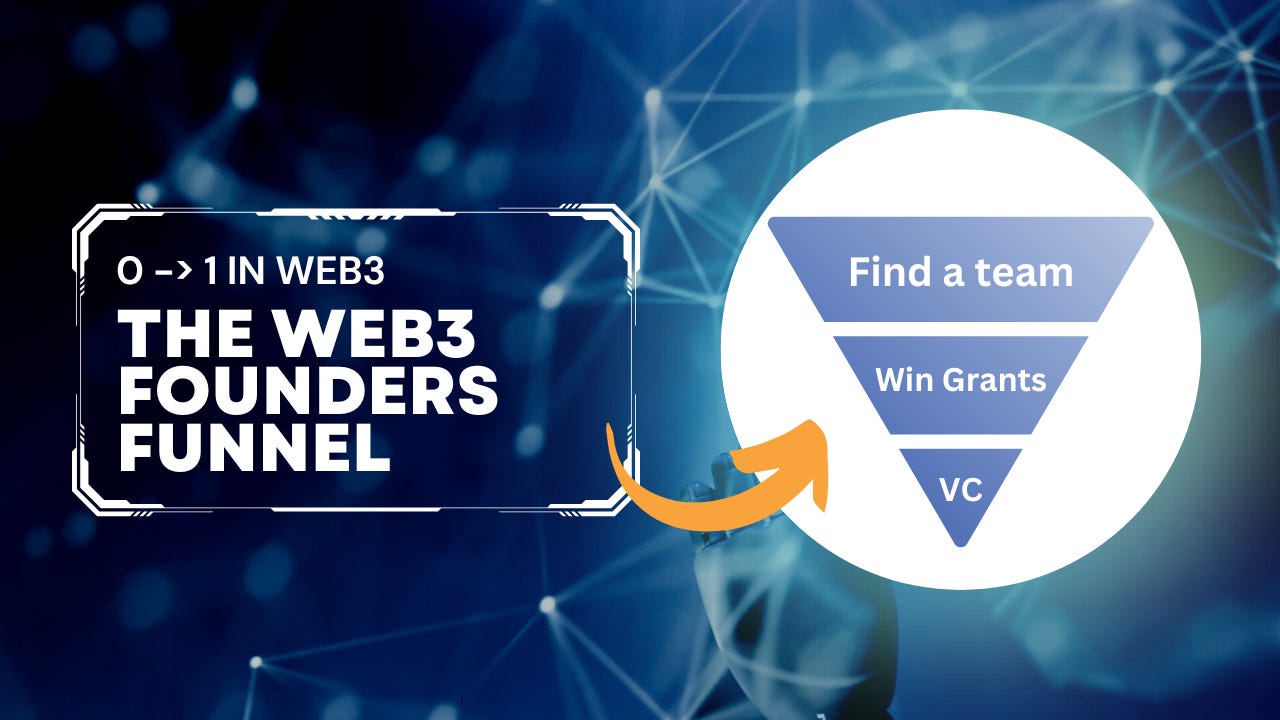Issue#4: The Web3 Founders Funnel
Going from 0 -> 1 in Web3
Reading time: 4 minsThe bar for VCs has gone up since the bear market hit. You will find very few who will invest on an idea.
Therefore the question is: How to find a team and build product to be venture ready?
In this edition we learn how to find a team, get early signs of traction and approach funders.
No idea how to get started…
This complaint typically comes from the “commercial” people as they want someone to build their great new idea.
Here are other common reasons people struggle to make actionable progress:
Need a CTO
Have no network into VCs
Don’t know how to attract the first users
People just don’t get it
Luckily there is a process you can follow so today we’ll explore in a bit more detail “The Web3 Founder Funnel” which I tweeted about a while ago:

Step 1: Find team = attend hackathons
Finding a motivated team to work alongside you on your start-up journey is absolutely critical.
The chances of a solo founder getting funded (unless they are a tech whiz) are slim.
Hackathons are a staple in Web3 with many chains putting them on to attract young and hungry developers to their ecosystems.
They are also a great place to find technical talent who are willing to give new ideas a go…
Just see the tweet below to see all the companies from a Solana Hackathon:


FAQ #1
Do you need to be able to code to go to a hackathon?
In short, no.
But you can’t turn up empty handed - whether its product management, marketing or communications skills you’ll need to bring something to the table to be a balanced team.
#2
Will the team work on my idea? Probably not.
You will have to sell them on the vision, and make sure it’s better than other ideas people have bought. Be flexible, their ideas may be better - weigh it all up.
Step 2: Bootstrap development with grants
If you have been to a number of hackathons as above you should find that you start to build a good book of contacts and maybe picked up a prize or two.
In my experience it’s at this point that well respected members of the tech community sit you down to give advice on getting funded via VCs.
My recommendation is not to follow this advice but rather build the product via grants so as not to give away equity.
This will free you to test your many hackathon ideas and take them to something that looks more like a monetizable system, without investors breathing down your neck.
There are plenty of grants for Web3 founders; here is a sample:

We covered grants in more detail in this edition which also went through how to find and apply to applicable grant programs.
Step 3: Scale = raise (Venture/Token)
Following step 1 & 2 you now have a small team, funded by grants with a nice clean cap table.
Now it’s time to turn our attention to investors.
While you have been working away on your ideas you have found the strengths and weaknesses of your team - maybe you are missing an operations person or a product manager.
You also have a good idea of running costs of your product, and in an ideal world have found some early users via press releases about the hackathons.
It’s time to summarise all the stuff you have done in a pitch deck to see what the market reception is like.
There’s a tonne of stuff out there on making great pitch decks, 2 of my favourites are:
Again through step 1 you may have crossed paths with a couple of friendly investors already - so make sure to get some outside eyes on the pitch before sending it far and wide. We’ll cover warm vs cold outreach in a later edition.
That’s it!
I hope this newsletter has given you some hope that there is a way to take an idea from 0 to 1.
Feel free to reach out to me on Twitter and I’ll be happy to share more about my journey through this crazy start-up world.
That’s it for this weeks newsletter. Thanks for reading 0xGregH! Subscribe for free to receive new posts and support my work.


